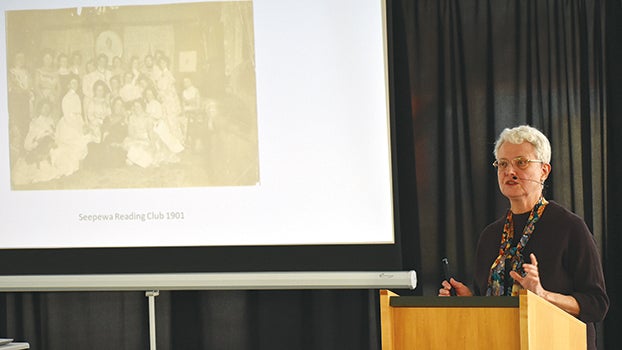Archivist discusses how women’s clubs in Niles were voices of positive change
Published 8:47 am Tuesday, March 19, 2019

- Suzanne Flandreau, an archivist, discusses the role of women’s clubs in Niles during a Spring History Series, which started Thursday night at the Niles District Library. (Leader photo/KELSEY HAMMON)
NILES — In her more than 30 years as an archivist, Suzanne Flandreau, of Niles, started to see a trend in local women’s clubs during the 20th Century.
While to some, the gatherings might seem like a place for teas and picnics, women’s clubs were so much more. Not only did they encourage women to go to college by sponsoring local scholarships, but they also inspired civic engagement and pivotal change in their communities.
On Thursday night, more than 30 people visited the Niles District Library to listen to Flandreau lead a presentation entitled, “Time Well Spent in Study and Pleasant Recreation.” The discussion is the first in the Spring History Series, hosted by the library and the Niles History Center.
“The 20th Century was a huge time of change for women,” Flandreau said. “It is interesting to see how these local clubs exemplified these changes.”
Flandreau discussed several clubs in Niles that made waves during their era, especially in civic engagement, education and work.
She started by talking about the Niles branch of the American Association of University Women, also known as the College Club.
A picture of the group was captured and published in the Niles Daily Star on May 20, 1957. Flandreau asked those in the audience to note that every woman pictured wore a hat, a style trend that was indicative of the time.
“If you were out and about, by golly, you wore a hat,” Flandreau said.
The goal of the AAUW, which got its start in 1916, was to bring college-educated women together to promote and encourage young women to pursue higher education. In 1921, the group awarded their first of many college scholarships to a young girl. While they did hold tea parties, the point of the gatherings was to further encourage senior women in high school to go to college.
There were also a host of reading clubs recorded in the area. For many women, during this time, the reading clubs were a source of informal education, connecting them with literature on science, art and politics.
Voting rights for women was another important topic that local clubs sought to promote.
Women in Michigan could vote in statewide elections in 1919. It was not until the 19th Amendment to the U.S. Constitution was ratified a year later that women could vote in federal elections.
As early as 1913, Niles clubs were advocating for women to be able to vote. The Monday Reading Club did so by creating a humorous play called “Votes for Men” which depicted “as man feared it might be if the suffrage bill passed” as an all all-female state legislature with the men petitioning to get in. The play, which was a hit, was one of many efforts to promote women’s rights.
“Now you think about people who forget to vote,” she said. “These women were serious. They really wanted that right.”
Flandreau discussed a host of other local women’s clubs that sought to bring about positive change in their community. The Women’s Progressive League, founded in 1912, was yet another example.
The club promoted building school playgrounds, raised money to fund an emergency supply of sanitary napkins for girls at the high school and helped to establish Island Park. They lobbied to elect a woman to the school board in 1913. In 1919, they successfully petitioned to the city council to appropriate funds for a visiting nurse, due to high rates of infant mortality. Flandreau said the nurse arrived just in time for the influenza outbreak.
The group also had some more conservative goals such as driving saloons from Berrien County and closing theaters on Sunday.
“I see this as a part of the idea at the time that women could have a constructive effect on civic policy as an extension of their female role in the home,” Flandreau said. “They had a definite agenda and seemed willing to rock the male establishment.”
Flandreau also discussed a club for young mothers called the Voguettes, as well as clubs for working women found at the former Simplicity and clubs that served the rural communities in southwest Michigan, like the Portage Prairie Home Economic Club.
Slowly the proliferation of local women’s clubs in the area began to dissolve throughout the 20th Century, but their legacy, Flandreau, said will continue to live on in their communities.
“The earliest women’s clubs, the reading clubs, were small groups of friends that gathered for self-improvement,” Flandreau said. “The microcosm is what makes the macrocosm. The local clubs are where all these issues become real.”





